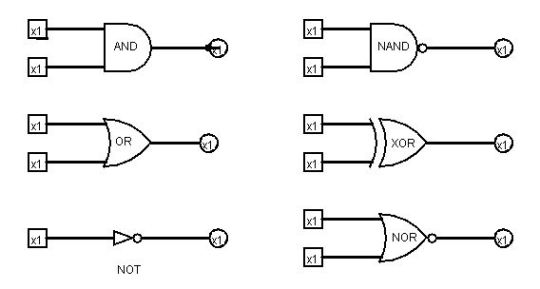#focus of interest
Beyond Descartes - Part 10
Taoism Meets Boolean Logic: Introduction

Logic gate symbols
(continued from here)
Before we can hope to comprehend Taoist arithmetic and geometry we need to take a short detour through Boolean logic. First and foremost, we need to see how Boolean logic[1] relates to Cartesian coordinates. That will provide what may be the best foundation available for understanding the Taoist approach to mapping of spacetime and the methodology which mandalic geometry derived from it.[2]
For Descartes, his coordinate system is one thing, his coordinate geometry another. For Taoism, the coordinate system is the geometry.[3] Boolean logic helps to explain how the two perspectives are similar, how different. Cartesian coordinates are static and passive. Taoist coordinates and the derivative mandalic coordinates are active and dynamic. In brief, the latter are changeable and self-changeable, a feat carried out by means of a brand of Boolean logic intrinsic to the system. Although it is true that Descartes’ coordinates do encode much the same information, that is not where their focus of interest lies. Accordingly they turn our own attention elsewhere and we overlook those inherent possibilities.[4]
Descartes’ geometric system is one based on vectors, that is, on both magnitude and direction. But in the scheme of things, the former has somehow eclipsed the preeminence of the latter in the Western hive mind. The opposite is true of Taoist thought and of mandalic geometry. Direction is uniformly revered as primary and prepotent. Magnitude, or scale, is viewed as secondary and subordinate. This mindset allows the Boolean nuances inherent in the system to come to the fore, where they are more easily recognized and deployed.
From such small and seemingly insignificant differences ensue entirely disparate worldviews.
(continuedhere)
Notes
[1] George Boole’s monumental contribution to symbolic logic was published in 1854 but was viewed as only an interesting academic novelty until the second decade of the twentieth century, when it was at last exhumed as a mathematical masterpiece by Whitehead and Russell in their Principia Mathematica.
[2] In Boolean logic (Boolean algebra) logical propositions are represented by algebraic equations in which multiplication and addition (and negation) are replaced with ‘and’ and 'or’ (and 'not’), and where the numbers '0’ and '1’ represent 'false’ and 'true’ respectively. Boolean logic has played a significant role in the development of computer programming and continues to do so.
[3] This is true also of mandalic geometry in its current formulation.
[4] This might be a proper place to proclaim that nature has little use for Descartes’ breed of coordinates, finding them far too stagnant and limiting for her purposes. Fortuitously, she devised her own choice coordinate stock long before Descartes thought to invent his.
© 2015 Martin Hauser
Please note: The content and/or format of this post may not be in finalized form. Reblog as a TEXT post will contain this caveat alerting readers to refer to the current version in the source blog. A LINK post will itself do the same. :)
Scroll to bottom for links to Previous / Next pages (if existent). This blog builds on what came before so the best way to follow it is chronologically. Tumblr doesn’t make that easy to do. Since the most recent page is reckoned as Page 1 the number of the actual Page 1 continually changes as new posts are added. To determine the number currently needed to locate Page 1 go to the most recent post which is here. The current total number of pages in the blog will be found at the bottom. The true Page 1 can be reached by changing the web address mandalicgeometry.tumblr.com to mandalicgeometry.tumblr.com/page/x, exchanging my current page number for x and entering. To find a different true page(p) subtract p from x+1 to get the number(n) to use. Place n in the URL instead of x (mandalicgeometry.tumblr.com/page/n) where
n = x + 1 - p. :)
-Page 293-
